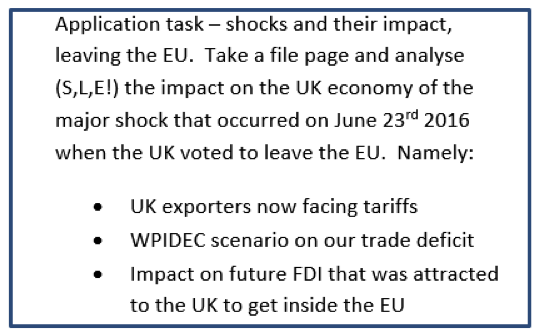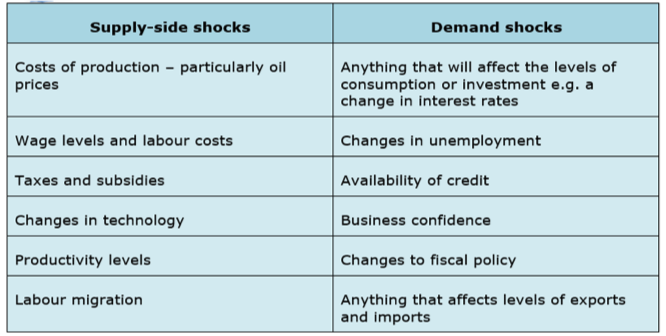Risks and Uncertainty
Exchange rate risks and forward markets
Many shocks hit home through the impact of the shock on exchange rates. In fact, ER can create smaller shocks on their own (e.g. going from a SPICED to a WPIDEC scenario and vice-versa). Exporters and importers need to deal in foreign exchange markets all the time. But there is a way of minimising the risk they face here via ‘forward markets’.
Some risks can be insured against: people insure their lives, their homes and their cars. Businesses that need to buy and sell in foreign currencies can insure against exchange rate changes using forward markets. These allow them to buy a certain quantity of a currency at a price that is agreed now, and they will receive the money on a particular date in the future. This is very useful for businesses that know they must pay for something in foreign currency on a future date and do not want to find that it is costing much more because the exchange rate of that currency has risen in the meantime.
The difference between risk, uncertainty and shocks
Risk
Situations where outcomes are known and can be calculated/quantifiable. E.g. insurance companies consider your age, gender, experience etc when selling you car insurance. They know that accidents are inevitable and will predict how many for any given type and number of drivers. They have mathematical models and will spread their risk between different types of drivers which is why some policy quotes are ridiculously expensive, if they have filled their quota for 18 year old learner drivers then they actually want to scare you off! Similarly, accountants assess the financial risks that a business is taking. Risk can be ‘managed’ and some actions are rejected as too risky.
Uncertainty
Factors outside of the business’s control (different to risk), outcomes that cannot be calculated with any accuracy. Tere are too many unknown variables so is therefore unpredictable. The business might be aware of these factors, but it does not reduce the uncertainty. For example: oil prices vary all the time, due to an arrange of factors, but we cannot calculate what they might be in a year’s time. OPEC, an oil cartel, reduced supply to the market which led to the ‘first oil price shock’ of 1973 – an interesting example to research into!
Using information about the kind of things that might go wrong and how to reduce the damage they can do reduces risk. Such as wearing seat belts in cars. Uncertainty produces shocks as well as minor problems. Both are unavoidable and must be dealt with.
‘What if’ contingency planning (contingency = emergency plan) can improve a business’s reaction, but shocks such as earthquakes/ash clouds/GFC banking crashes/tube strikes cannot be controlled by business. Shocks are events that have a dramatic impact and are totally unexpected.
To summarise, risks can be quantified. The probability of an event occurring can be calculated by looking at the circumstances in which it has occurred in the past. Therefore businesses can work out how risky a possible course of action is and make allowances for this in their planning.
Uncertainty is different: it covers situations that may or may not happen but there is no way of knowing how likely they are. We simply do not know how likely it is that some particular events will occur. The difficulty is that government policies take time to work and decision takers have to adopt the policies they think they will need in the future on the basis of what has been happening lately. If they do not make allowances for time lags, their policies may turn out later to have been mistaken.
Shocks are unexpected changes that have a significant impact on the economy. They may be caused by natural disasters or by human error. The most recent was the Global Financial Crisis that developed in the period between 2007 and 2009, which was caused by excessive risk-taking in the financial sector.
Time lags
Adjusting to change takes time. Changes in employment usually occur 12-18 months after a policy has been implemented. It takes time for things to play out in an economy! Business may take a similar amount of time to react and grasp the implications of change and thus take action. Changes in regulation and politics may lengthen the adjustment process.
Economics shocks create scenarios that take time to unfold – e.g. the 2011 Japanese tsunami and its effects on JIT manufacturers (supply chains destroyed!). Even when solutions have been identified and implemented, further resistance to change or adjustments maybe required – especially if labour immobilities slow down the process of change.
Insurance
When we insure against a certain type of risk, a premium is paid. In return for this payment, the insurance company promises to compensate the insured person or business in event of the risk actually happening. Insurance is a way of spreading risk by sharing their costs. “The premiums of the many support the risk/claims of the few”. It protects the insured from some of the consequences of unforeseen events.
The premium covers the cost of compensating the insured when things go wrong, as well as the admin cost to the insurance company of offering the service. It easy to appreciate why the terms and conditions are so restrictive and spell out exactly what kind of liability the insurance company is taking on. Anything excluded in the contract will mean that a claim will be denied or limited. The insurance company can find a way to not pay out, the generally will!
Businesses need many types of insurance, including buildings and equipment, vehicles, ships/aircrafts and public liability insurance (in case someone from outside the business gets injured/affected by the business activities/employee gets hurt whilst working. Required by law).
There is always a choice about how much insurance is needed – e.g. life insurance. The higher the sum insured, the bigger the premium. Insurance can be expensive so many people try to keep it to a minimum. On a business level, being adequately insured could make the difference between survival and closing down.
Equally it is an overhead which must be considered when choosing your pricing strategy. Some businesses may be tempted to carry their own risk (i.e. take out the legally required insurance policies only). This makes sense only if they know they have adequate reserves to cover all eventualities (e.g. corner shop vs Apple and its $40billion reserves!).


